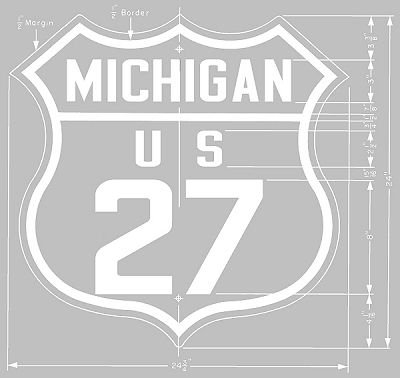
Forever Gone,
Never Forgotten
To help reduce confusion along the US-27/US-127 corridor in Michigan, the entire route is now signed as US-127. Michigan Department of Transportation crews replaced all US-27 signs in 2002.

|
Michigan US-27:
Forever Gone, Never Forgotten To help reduce confusion along the US-27/US-127 corridor in Michigan, the entire route is now signed as US-127. Michigan Department of Transportation crews replaced all US-27 signs in 2002. |

Evolution of the US Highway Route Marker
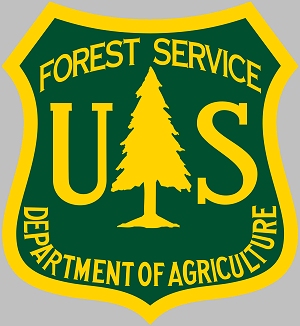
|
1926 - Inspired by a 1905 US Department of Agriculture Forest Service logo, Frank Cnare of Wisconsin State Highway Department submits to the USDA's Joint Board on Interstate Highways his proposed design for a US highway route marker (sign). A final design was adopted in August 1926 by the board whose task was to establish a nationwide highway system. Cnare's "shield" design becomes national standard for US highway route markers.
However, Wikipedia reports that the shield design was actually the brainchild of Lou Boulay (Ohio), E. W. James (chief of US Bureau of Public Records, Design Division), and Frank Rogers of Michigan, using the Great Seal of the United States as their inspiration. Who's correct? Please email me. Thank you. |
|
|
|
|
|
1926-1930 - First US route markers in Michigan are made from cast iron, 16"x16", about ½"-1" thick, and weigh a hefty 13 pounds. Made from molten iron poured into molds then cooled by electric fans. Signs are so heavy, often fall off wooden posts on which they are mounted. 16"x16" becomes "standard" size. |
|
|
|
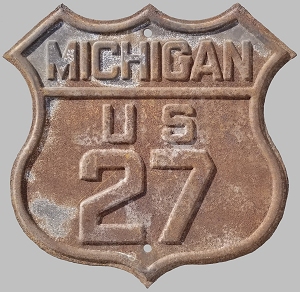

Above, my 16"x16" embossed steel sign. I had the rust chemically removed, then I painted it primer gray. |
1930 - Michigan State Highway Department joins growing national trend and switches to embossed steel for all signage; easier than cast iron to mass produce and mount. |
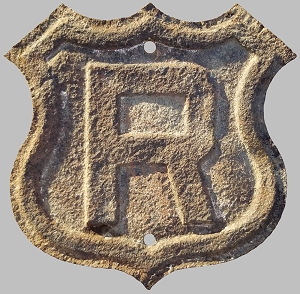
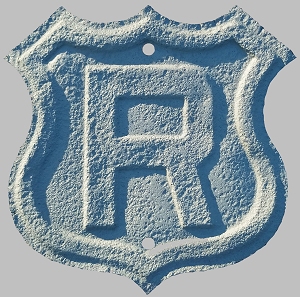
Above, my 9"x9" embossed steel Directional Letter sign. I had the rust chemically removed, then I painted it primer gray. |
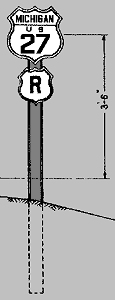 The Manual and Specifications for the Manufacture, Display, and Erection of US Standard Road Markers and Signs (January 1927) includes US Directional Letters that bear the letter "R" or "L." These signs were posted below the US Route Marker to indicate that the US Highway turns to the right or left at the next intersection. They had the same black/white color scheme as the Route Marker. By 1948, all the "R" and "L" signs had been replaced by arrows.
The Manual and Specifications for the Manufacture, Display, and Erection of US Standard Road Markers and Signs (January 1927) includes US Directional Letters that bear the letter "R" or "L." These signs were posted below the US Route Marker to indicate that the US Highway turns to the right or left at the next intersection. They had the same black/white color scheme as the Route Marker. By 1948, all the "R" and "L" signs had been replaced by arrows.

|
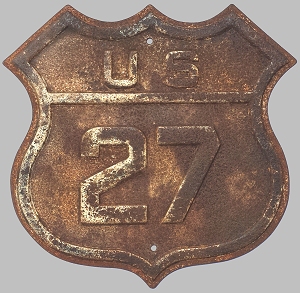

Above, my 12"x12" embossed steel sign. I had the rust chemically removed, then I painted it primer gray. |
1930 - Michigan also starts using 12"x12" shield with embossed border and numerals, but no state name across top. Used in populated areas where speeds are slower. |
|
|
|
|
|
Late 1930s - Larger embossed steel shields (24"x24") used at junction assemblies, turns, and where greater visibility is needed to direct motorists. Weigh 9 pounds.
|
|
|
|
|
|
World War II - Due to shortage of steel, signs are made of plywood. Numerals are painted, not embossed. State saves money and materials for war effort. Signs are repainted as needed. Embossed steel sign production resumes after Japan surrenders in 1945. |
|
|
|
|
|
1948 - Die-cut reflective sheeting material Scotchlite®, made by 3M, replaces embossed steel. Michigan uses remaining steel stock, but without embossment, thus thousands of flat steel die-cut signs are made with Scotchlite®. |
|
|
|

Above, my 24"x24" die-cut aluminum sign. |
1951 - Michigan switches from die-cut steel to flat aluminum sheeting with reflective sheeting. |
|
|
|
|
|
1952 - Disgruntled employee sets fire to Michigan State Highway Department building in Lansing; destroys building and contents; leads to creation of 1952 Michigan Manual of Uniform Traffic Control Devices (MMUTCD), establishing the standard for evolution of modern reflective signage across state for next 11 years. |
|
|
|
|
|
1956 - Michigan State Highway Department starts using 36"x36" US route makers on interstate and divided highways. Used well into late 1970s on US-27 north of Lansing; last ones removed in early 1990s. |
|
|
|
|
|
1963 - MMUTCD recommends 24"x24" as standard size for 2-digit US route markers. Larger 36"x36" and 42"x36" size shields without state name now used, especially at junctions, and where greater visibility is needed by motorists. |
|
|
|
|
|
1973 - Michigan begins to slowly replace die-cut aluminum with rectangular shields, painted with shield image and larger numerals. |
|
|
|
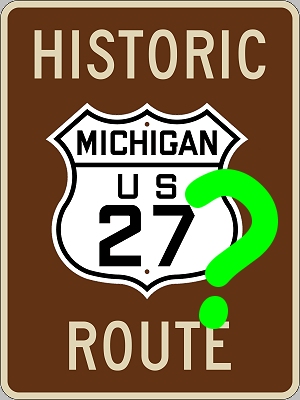
|
Historic Route? Efforts are underway to have what used to be US-27 in Michigan officially designated as an historic route. While House Resolution 319 adopted in August 2010 is a step in the right direction, authority to officially designate the route as an "historic route" (and post official signage) rests with the Michigan Department of Transportation, each county, and each city along the route. If it happens, it's gonna take a LOT of hard work. Stay tuned... film at 11. |
My thanks to these excellent contributors/resources: Gene Hawkins, Richard Moeur